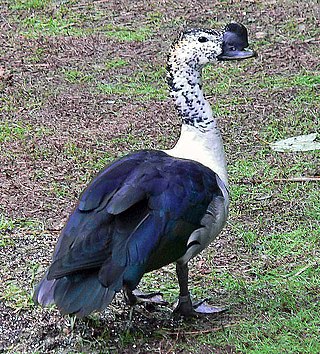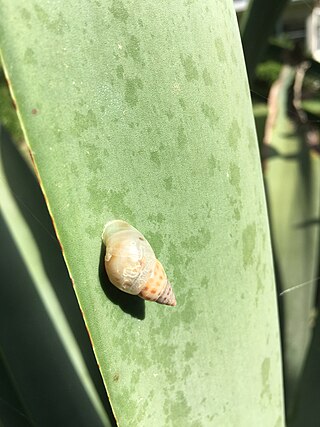
Sarkidiornis is a genus within the family Anatidae. Sarkidiornis is sometimes considered a monotypic genus with its sole member the knob-billed duck, a cosmopolitan species. Most taxonomic authorities, however, split the species into two:

The Hemiphractidae are a family of frogs from South and Central America. Previously, this group had been classified as a subfamily (Hemiphractinae) under family Hylidae. More recent research classifies these genera into their own family, or sometimes into three separate families: Amphignathodontidae, Cryptobatrachidae, and Hemiphractidae. An active question still exists as to which of these groupings is more accurate.

Reticulariaceae is a family of slime molds recognized by the Integrated Taxonomic Information System and is composed of the genera Dictydiaethalium, Enteridium, Lycogala, Reticularia, and Tubifera.

Sicyopterus griseus, the Clown goby, is a species of goby endemic to India and Sri Lanka, where it is found in estuaries, blackwaters, and fresh waters. The populations within Sri Lanka is not yet internationally accepted, due to lack of evidences. This species can reach a length of 9.7 centimetres (3.8 in) SL.

Narcine brunnea, the brown numbfish or brown electric ray, is a species of numbfish in the family Narcinidae. It is found in Indo-West Pacific countries such as Pakistan off coast, India, Sri Lanka, to the Gulf of Thailand. They mainly live in continental waters, both inshore and offshore. The maximum length is about 22 cm (8.7 in).
Hylaeus krombeini is a bee species endemic to Asia.
Hylaeus sedens is a bee species endemic to Asia.
Lipotriches fervida is a species of bee in the genus Lipotriches, of the family Halictidae.
Lipotriches edirisinghei is a species of bee in the genus Lipotriches, of the family Halictidae.
Ceylalictus horni is a species of bee in the genus Ceylalictus, of the family Halictidae.
Ceylalictus cereus is a species of bee in the genus Ceylalictus, of the family Halictidae.
Ceylalictus taprobanae is a species of bee in the genus Ceylalictus, of the family Halictidae.
Lasioglossum semisculptum, also known as the Lasioglossum (Ctenomia) semisculptum, is a species of bee in the genus Lasioglossum, of the family Halictidae.
Lasioglossum serenum, also known as the Lasioglossum (Nesohalictus) serenum, is a species of bee in the genus Lasioglossum, of the family Halictidae.
Lasioglossum alphenum, also known as the Lasioglossum (Sudila) alphenum by Sakagami et al. (1996), is a species of bee in the genus Lasioglossum, of the family Halictidae.
Anthidiellum krombeini is a species of leaf-cutting bee in the genus Anthidiellum, of the family Megachilidae.
Coelioxys formosicola is a species of leaf-cutting bee in the genus Coelioxys, of the family Megachilidae.
Tetraloniella taprobanicola, also known as Tetraloniella (Tetraloniella) taprobanicola, is a species of bee belonging to the family Apidae subfamily Apinae. It is found endemic to Sri Lanka.

Drymaeus dormani, common name the manatee treesnail, is a species in the family Bulimulidae. These snails were once used to control sooty mold on citrus trees in central Florida.

Notiosoricini, whose members are known as the North American gray shrews, is a tribe of shrews in the family Soricidae, including the genera Megasorex and Notiosorex. They are found across the southwestern United States and most of Mexico.






